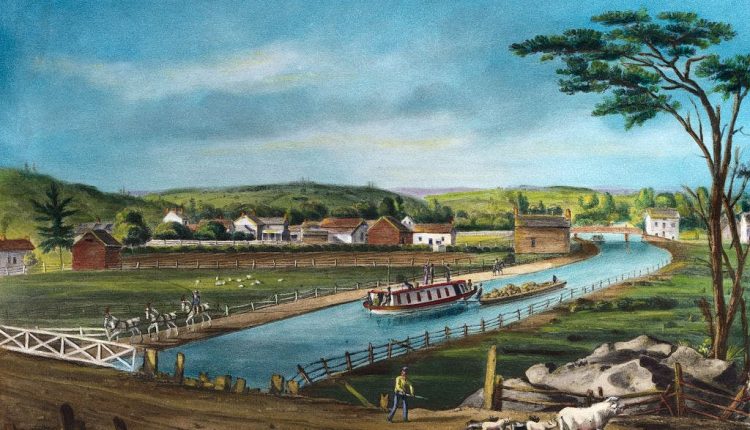On this day in history, October 26, 1825, Erie Canal opens, transforming American infrastructure, commerce
The Erie Canal, a major achievement in transportation infrastructure that connected the Great Lakes to the Atlantic Ocean and ignited American economic development, was completed on this day in history, Oct. 26, 1825.
“The Erie Canal played a major part in commerce in the history of the United States,” reports the Library of Congress.
“Its creation helped to make New York City the chief port in the United States and opened the western part of the state and other western territories to increased settlement and trade.”
ON THIS DAY IN HISTORY, OCTOBER 25, 1944, FIRST KAMIKAZE SUICIDE PILOTS ATTACK US NAVY IN WORLD WAR II
The canal began upon the shores of Lake Erie in Buffalo and traversed about 350 miles east, where it made a sudden southward turn around Troy and emptied into the Hudson River in downtown Albany.
It featured 18 aqueducts, 83 locks and a 570-foot change in elevation.
Construction of the canal began in 1817. Its opening eight years later was celebrated with a “wedding of the waters” officiated by New York Gov. DeWitt Clinton, the canal’s leading champion.
Gov. Clinton made a 10-day journey down the canal from Buffalo to the Hudson River and then to New York City aboard the packet boat Seneca Chief.
He ceremonially poured two casks of Lake Erie water into the Atlantic, marking the union of the two bodies for the first time.
ON THIS DAY IN HISTORY, MAY 20, 1927, CHARLES LINDBERGH DEPARTS FOR HIS FIRST SOLO NONSTOP FLIGHT ACROSS THE ATLANTIC
“The effect of the Canal was both immediate and dramatic, and settlers poured west,” reports the state of New York in its official history of the canal.
“The Erie Canal’s cost of construction was recovered in just nine years.”
“The explosion of trade prophesied by Governor Clinton began, spurred by freight rates from Buffalo to New York of $10 per ton by Canal, compared with $100 per ton by road. In 1829, there were 3,640 bushels of wheat transported down the Canal from Buffalo. By 1837 this figure had increased to 500,000 bushels; four years later it reached 1 million.”
The federal government refused to pay for the project. So Clinton marshaled support from New York legislators and taxpayers.
It proved public money well spent, a major commercial success virtually unheard of among public infrastructure projects today. The Erie Canal’s cost of construction was recovered in just nine years, according to state history.
“The Erie Canal ensured the status of New York City as America’s premier seaport, commercial center, and gateway to the interior — eclipsing New Orleans, Philadelphia, Boston and Baltimore,” notes the Erie Canalway National Heritage Corridor website.
“It helped New York become the ‘Empire State’ — the leader in population, industry and economic strength.”
The Buffalo Maritime Center and New York State Canal Corporation are currently building a replica of the Seneca Chief.
Officials plan to recreate the “wedding of the waters” ceremony to celebrate the canal’s 200th anniversary on Oct. 26, 2025.
The canal was largely rendered commercially obsolete by advances in train transportation, then trucking and finally by the opening of the St. Lawrence Seaway in 1959, which opened up the Great Lakes to much larger ocean-going vessels.
Yet appreciation of the canal’s profound role in transforming the heartland, New York City and the American economy has grown in recent years.
The Erie Canal “helped New York become the ‘Empire State’ — the leader in population, industry and economic strength.”
The Erie Canalway National Heritage Corridor was established by Congress in 2000, while the project’s impact on the nation is still being felt today.
The Erie Canal “was the longest artificial waterway and the greatest public works project in North America,” says the Erie Canalway National Heritage Corridor.
“Equally important, the Erie Canal became a central element forging our national identity. Built with a combination of vision, determination, ingenuity and hard work, the Erie Canal solidified these central elements of our American character.”
For more Lifestyle articles, visit www.foxnews.com/lifestyle.
Read the full article here

